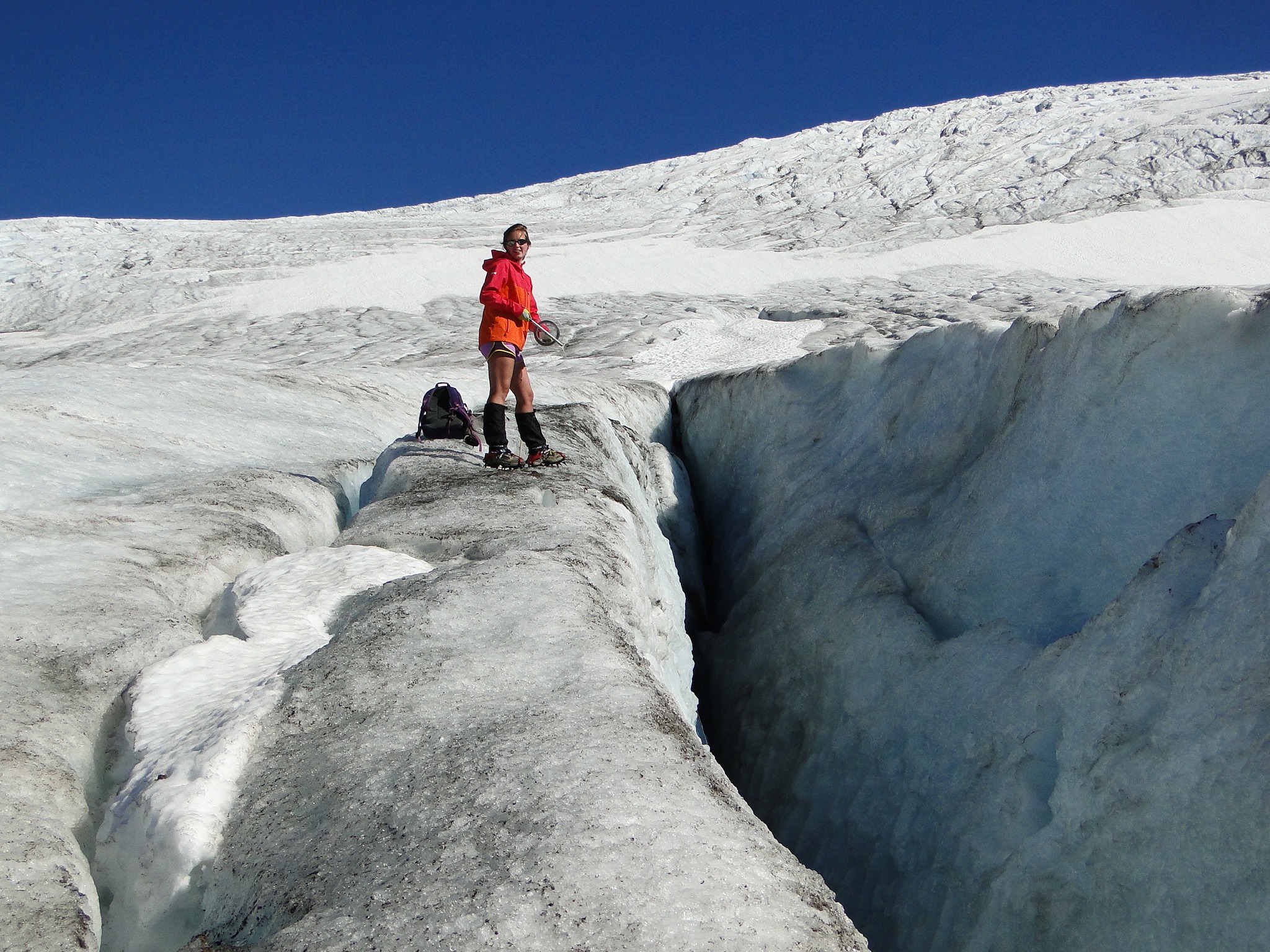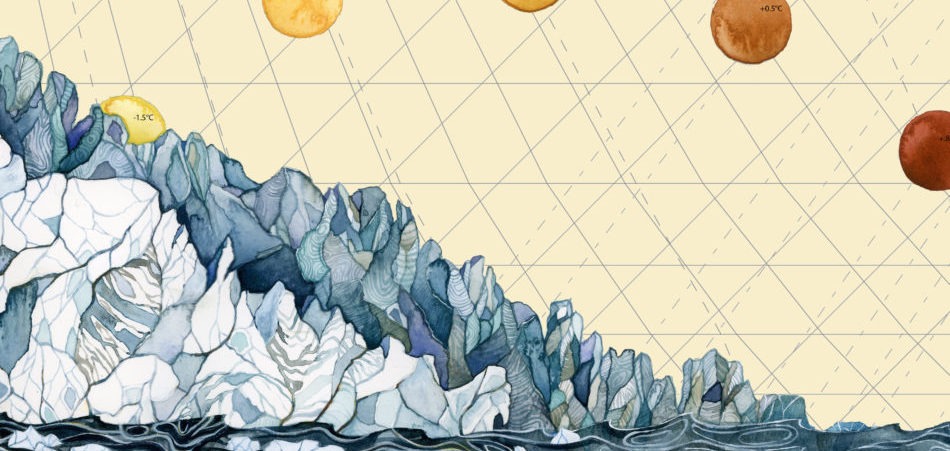Through the Arts Community space and weekly blog posts the MAHB has been highlighting artists who create work taking on the themes of sustainability and equity. We were pointed in the direction of Jill Pelto and her amazing work. A Masters student in the University of Maine’s Earth and Climate Science Department, working with Dr. Brenda Hall on paleoclimate research in the Antarctic, Jill also holds an undergraduate degree in Studio Art. Jill’s creative work incorporates scientific research and data into striking pieces to raise awareness about important environmental topics, particularly Climate Change. I was lucky enough to connect with Jill for a quick interview.
Hi Jill, thanks for taking the time to talk with me today. To start off can you share a little about yourself: who you are, your interests, and how you came to be a scientist and artist?
I am 24 years old and graduated from the University of Maine in December 2015 with a double major in Studio Art and Earth Science. I grew up with a family who loved the outdoors, which fostered my love of nature, and with a twin sister with whom I could constantly draw. Aside from making art, my favorite things include cross-country and downhill skiing, reading, running, camping, traveling, and spending time with my friends and family.
I have assisted with research on the mountain glaciers of Washington and British Columbia, in the Dry Valleys and Transantarctic Mountains of Antarctica, over the rolling hills and carved cirques of the Falkland Islands, and around the aqua lakes and ochre mountains of New Zealand. These wonderful experiences worked with my interdisciplinary track (taking painting and climate change courses simultaneously at UMaine), and made me realize I could use my creative skills to communicate information about extreme environmental issues with a broad audience. I create artwork about the research I have been involved with as well as a myriad of other important topics. I believe that art is a uniquely articulate lens: through it I can address environmental concerns to raise awareness and inspire people to take action.

I have had the chance to look through some of the amazing artwork on your site (jillpelto.com), and found your incorporation of data into them so captivating. Was this a technique you have always used, or was it something you have developed more recently?
I developed this more recently, while working on my Undergraduate Honors Thesis Project titled Art as a Tool to Communicate Science. I had been struggling for a long time with how to make art about the important issues I read online, or see while doing fieldwork, but in the summer of 2015 I was so blown away by the effects of global warming in Washington, that I finally hit upon using actual data. August 2015 was my 7th consecutive year working on North Cascade National Park glaciers with my father, Dr. Mauri Pelto, and his North Cascade Glacier Climate Project (NCGCP). That year the drought in Washington absolutely devastated the glaciers, the water supply, and the surrounding ecosystem; I returned home to Maine determined to create a series that could show people just how drastic these changes are. The NCGCP has been working on these glaciers since 1983, and this year when I was looking at the data collected and calculated over 33 years, I realized this sharply declining graph line would translate really well as the profile of a glacier. This idea became Decrease in Glacier Mass Balance, and uses measurements from 1984-2014 of the average mass balance for a group of North Cascade, WA glaciers. Mass balance is the annual budget for the glaciers: snow gain minus snow loss. This idea lead to a data-inspired portfolio.
![Jill Pelto | Decline in Glacier Mass Index. This piece uses measurements from 1980-2014 of the average mass balance for a group of North Cascade, WA glaciers. [2] Mass balance is the annual budget for the glaciers: total snow accumulation minus total snow ablation. Not only are mass balances consistently negative, they are also continually decreasing.](https://mahb.stanford.edu/wp-content/uploads/2017/06/Glacier.jpg)
I sometimes find that my interactions with the natural world are influenced by my understanding and interests in ecology. I am curious, do you find how you experience nature as a scientist differs from how you experience it as an artist?
I really like this question. The way I experience nature as an artist and as a scientist has become intertwined. For example, when I visit North Cascades Glaciers in Washington, I simultaneously see their major retreat just over the past 8 years and the new forms of beauty these changes bring. A lack of snow on the glaciers in the summer means that a lot of old and stunning features in the ice are exposed, yet I also know that because they are exposed, they will melt away. For me there is no comparison to being immersed in nature, and it fosters a deep relationship that is as important as that with family and friends. So when I see crevasse fields, lake sediment cores, and old moraines, I want to share with others how incredible it is to step outside and observe how the past has shaped the beauty of the present

Are there ways that these lenses complement each other? How does being a scientist influence your art? How does being an artist influence your science?
Art and science both require a lot of creative thinking and are driven by observation: what is happening in the world and how it can be depicted in art, studied through research, and shared and communicated with people. Scientists and artists are both passionate about understanding our world, but go about it in different ways. The scientist makes new discoveries and gains knowledge, and the artist can use their visual and/or audio skillset to share this.
You have expressed that you wish to use your creative skills to communicate information about extreme environmental issues with a broad audience. Can you explain the role you feel art has in communicating science, especially in the realm of environmental issues? Do you find that art reaches a different audience than typical science communication?
I think that art is so powerful because of the importance of the visual, many people respond more to this than to the writing in a scientific paper. My art can show the essential information of an environmental issue, but is also expressive through its beauty and its story. My hope is that this combination of intellectual and emotional content will be meaningful to a lot of people.
![Jill Pelto | Habitat Degradation: Deforestation. This piece uses data showing the decline in rainforest area from 1970 to 2010. [3] These lush ecosystems are disappearing before our eyes, and with them, millions of beautiful species. Jill is quite certain that anyone would agree that a tiger is a magnificent creature, yet how many people realize that they are critically endangered? For this series Jill chose to separate the animals from their habitat, because that is ultimately what we are doing. The tiger is trapped outside the forest, cornered. He is defensive and angry that we are sealing his fate.](https://mahb.stanford.edu/wp-content/uploads/2017/06/Deforestation.jpg)
Are there audiences that are still not reached by either? Are there ways we could broaden the reach?
Definitely. And I guess that is an answer I am pursuing with my career, and don’t yet know. To find out how to broaden the reach I have to keep making art, keep communicating science, and learn, based on reactions, what different people respond to. My goal is to inspire as many people as possible to care about environmental responsibility, so it is a huge win for me if anybody who does not necessarily take any action to protect our world is touched by my art.
One reason why the MAHB has launched this initiative, is because of the potential for art to illicit a more emotional response than something like a table of data. Have you experienced the ability for your art to connect with people in a different way than your science?
I certainly have, people have responded a lot to the way I elicit emotional content from data and graphs. The trend line is starker. A graph with the declining volume of glaciers becomes the profile of a glacier, and suddenly the visual makes the data come to life. That is ice painted under the graph, and people can see it decreasing with the line, people can understand the loss. When I read a scientific paper or article detailing, for example, sea level rise estimates for the next century, I am floored. I want to share this scary but true reality with others, because knowledge is a power in itself. But I find that most people I know don’t take the time to read these articles, so I am trying to inform them in a way that I hope catches their attention more.

What is next for you? How can people follow your work?
I am working on my Masters in UMaine’s Earth and Climate Science Department, working with Dr. Brenda Hall on paleoclimate research in the Antarctic. The project focuses on understanding how sensitive the Antarctic Ice Sheet is to factors such as sea level rise, and increasing oceanic and atmospheric temperatures. Additionally I am planning to be a part of several exhibitions this summer, including Art of Climate Science featuring work by UMaine’s Climate Change Institute in Belfast, Maine, and a show in UMaine’s Hudson Museum on campus. In August I will work with the North Cascade Glacier Climate Project for my 9th consecutive year, and in December I will be heading down to the Antarctic for the second field season of my Masters research.
People can follow my work at my website (jillpelto.com), or for more continuous updates through my Instagram (instagram.com/jillpelto).
![Jill Pelto | Climate Change Data. This piece uses multiple quantities: the annual decrease in global glacier mass balance, global sea level rise, and global temperature increase. The numbers on the left y-axis depict quantities of glacial melt and sea level rise, and the suns across the horizon contain numbers that represent the global increase in temperature, coinciding with the timeline on the lower x-axis.[1]](https://mahb.stanford.edu/wp-content/uploads/2017/06/Climate-Change-Data-1.jpg)
It sounds like you have a lot of exciting opportunities coming up to expand on the incredible pieces you are creating and your efforts to reach more people. Best of luck with your exhibitions, and thank you for taking the time to share your work.
[1] Data references available at www.jillpelto.com
[2] Reference: blogs.agu.org/fromaglaciersperspective/
[3] Reference: awsassets.wwf.es
The above post is through the MAHB’s Arts Community space –an open space for MAHB members to share, discuss, and connect with artwork processes and products pushing for change. Please visit the MAHB Arts Community to share and reflect on how art can promote critical changes in behavior and systems and contact Erika with any questions or suggestions you have regarding the space.
MAHB Blog: https://mahb.stanford.edu/creative-expressions/scientific-data-art/
The views and opinions expressed through the MAHB Website are those of the contributing authors and do not necessarily reflect an official position of the MAHB. The MAHB aims to share a range of perspectives and welcomes the discussions that they prompt.
